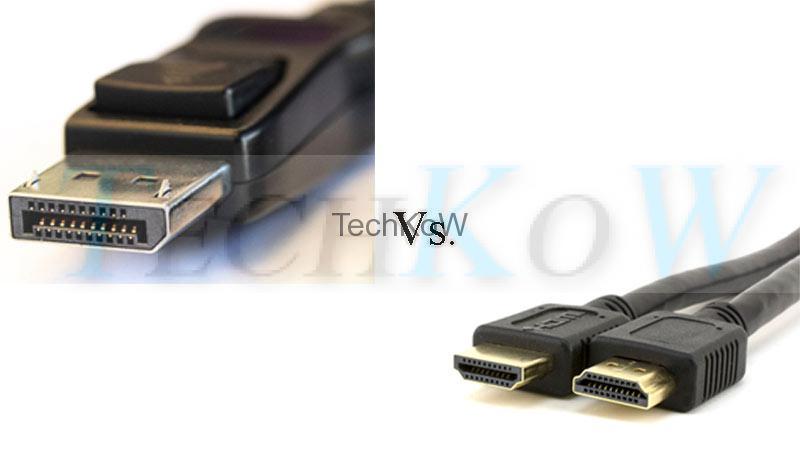VGA, DVI-D, DisplayPort (DP), and HDMI are the 4 major video output sources you find in Monitors, LCDs, and LEDs. These are the famous video outputs that started in the 1990s. In 1990s there was no concept of 1080p, 2160p and 4320p quality. People were used to watching videos on 240p max, but now everything is changed.
Now several video output cables have arrived, and the result has been improved a lot. VGA and DVI-D were famous, but DisplayPort (DP) and HDMI have won the rat race. These two display outputs have left the VGA and DVI-D outputs behind.
There is a lot of competition between DisplayPort (DP) and HDMI developers. So what do you think? Who will win this competition? I will answer this question, and let’s start the comparison between these 2 display outputs.
HDMI Release Date and Latest Update
HDMI stands for High-Definition Multimedia Interface. Its first cable was designed in 2002, and 19 years have been passed, this company is providing its services. It has both signals, including audio and video signals.
When you connect from the HDMI port to your display source, you don’t have to connect the speakers because this HDMI port has the audio signals installed. The voiceover of the HDMI port depends on your Monitor’s Audio Support, and it has numerous Audio Signals installed. So you get an outstanding audio and video signal.
The latest update of the HDMI port is HDMI 2.1, and I will mention its display features, but let me introduce DisplayPort (DP).
DisplayPort (DP) Release Date and Latest Update
When we see the short form of DisplayPort, its DP, and its first video output was released in 2008 by VESA. It is the best video output source delivering audio and video signals at the highest quality.
It has a 20-pin connector, and HDMI has a 19-pin connector, but connecting an LCD or LED with these pins is easy. So it doesn’t matter that DP comes in 20 pins and HDMI comes with 19 pins. Both are easy to connect, and both deliver vibrant displays.
Its latest update is DisplayPort (DP) 2.0, and viewing 8K quality videos is not a problem if your monitor supports 8K resolution. So that was a little bit of introduction of DisplayPort and now let’s see the image quality of both of them. After seeing the comparison table, you’ve to decide which video output source is best?
So the latest update from DisplayPort (DP) is 2.0, and from HDMI, it’s 2.1. So we will compare the results of these 2 displays, and hopefully, you will get the answer. After reading the comparison, it would be easier for you to decide which display output is best.
DisplayPort (DP) 2.0
At first, we’ll discuss the features of DisplayPort (DP) 2.0 and then HDMI.
This DisplayPort’s latest version is 2.0, and you get multiple display options with different refresh rates on different qualities.
Bandwidth
Before explaining the refresh rates and image qualities, let me reveal the bandwidth you get with this DP 2.0 port. The maximum bandwidth with this DP 2.0 is 80 GB/s. So in each second, it can process 80 GB of data, and that’s good for an 8K display.
720p Result Output
When you connect your graphics card through DP 2.0, you’ll be surprised to see how high the refresh rate can go on DP 2.0. On the 720p result, you get a 2680Hz refresh rate, and I’ve not seen any monitor whose refresh rate reaches 2680Hz. So the developers of DP 2.0 have added an extra backup for people who play games or watch videos at 720p.
2680Hz refresh rate is such a surprising number that no one had thought. So at 720p, 2680Hz is the best number that DP 2.0 offers.
1080p Result Output
On 1080p, your expectation shouldn’t decrease. DP 2.0 offers the best refresh rate on 1080p quality. You get a 1200Hz refresh rate with DP 2.0 port, and till yet, no monitor with a 1200Hz refresh rate has shown up.
1440p Result Output
1440p is the best result, and most people are watching videos in this 1440p quality. I’ve seen many people who watch videos at 1440p. Even I watch videos on YouTube at 1440p quality. So the DP 2.0 offers a 600Hz refresh rate of 1440p quality. So playing games at 1440p quality would be a charm because 1440p quality entertains the gamers.
2160p Result Output
2160p, it means 4K. Now, this 4K quality was expensive when it was first introduced, but now, 8K quality is released, and it has decreased the demand of 4K, so it’s getting cheaper day by day.
This DP 2.0 offers a 240Hz refresh rate of 4K quality, and there were several gaming monitors available in the market offering 4K quality on 240Hz refresh rate. So that’s the kind of number that fits best with DP 2.0 and is on gamers’ radar.
So gamers can play games at 4K quality when they get output from their graphics card through DP 2.0 port. Several graphics cards are available in the DP 2.0 format, and NVIDIA GeForce RTX 3090 is one of them.
4320p Result Output
The last quality that is available in the market is 8K. No other quality is introduced, so 8K is the last number and delivers the highest image quality.
So if you want an 8K quality display, then DP 2.0 offers a 60Hz refresh rate on 8K quality. This 60Hz is more than enough because the quality is 8K, and people get surprised when they see 8K quality for the first time. The PNY GeForce RTX 3090 is the graphics card offering DP 2.0 output. You can visit bigeno.com to read the complete review of this graphics card.
So that’s what this DP 2.0 offers, and now let’s jump to our second display option, HDMI.
HDMI
Again, bandwidth is what matters a lot, and let’s start with bandwidth.
Bandwidth
HDMI 2.1 is the latest release from HDMI developers, and the maximum bandwidth with HDMI 2.1 is 48 GB/s. So DP 2.0 won because it offers 80 GB/s bandwidth.
720p Result Output
At 720p, the maximum refresh rate you get is 1560Hz, and that’s good for people who play games or watch videos at 720p, but DP 2.0 again wins from HDMI 2.1.
1080p Result Output
On 1080p, you get a 720Hz refresh rate, and DP 2.0 has again defeated the HDMI 2.1 in the refresh rate part on 1080p quality. You can find numerous apps on this website that display a 1080p quality screen for their users.
1440p Result Output
On 1440p, you get a refresh rate of 360Hz, and some monitors offer a 360Hz refresh rate. So people who get a connection through HDMI 2.1 can enough the refresh rate of 360Hz.
2160p Result Output
At 2160p, you get 120Hz, and monitors with 120Hz refresh rates are available. But again, DP 2.0 won because on 2160p. You get a 240Hz refresh rate.
4230p Result Output
The final output is 4320p, and HDMI 2.1 has disappointed the users by adding a 30Hz refresh rate in its 8K quality section. A standard monitor’s refresh rate is 60Hz, but 30Hz doesn’t fit well because people are addicted to 60Hz.
So these were the display qualities and refresh rates offered by HDMI 2.1. Now, what is your answer? My answer is that DP 2.0 has won and HDMI 2.1 has lost.
In the upcoming days, hopefully, the HDMI developers will release a cable providing more refresh rates in every quality, but now DP 2.0’s quality is higher than HDMI 2.1
So thanks for reading this guide, and I’ll see you in the next one.





